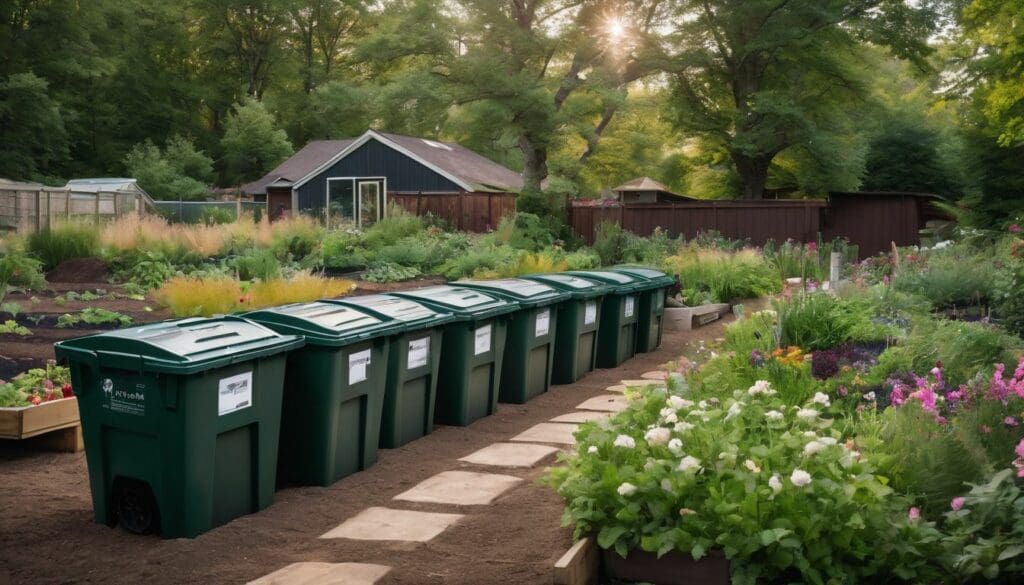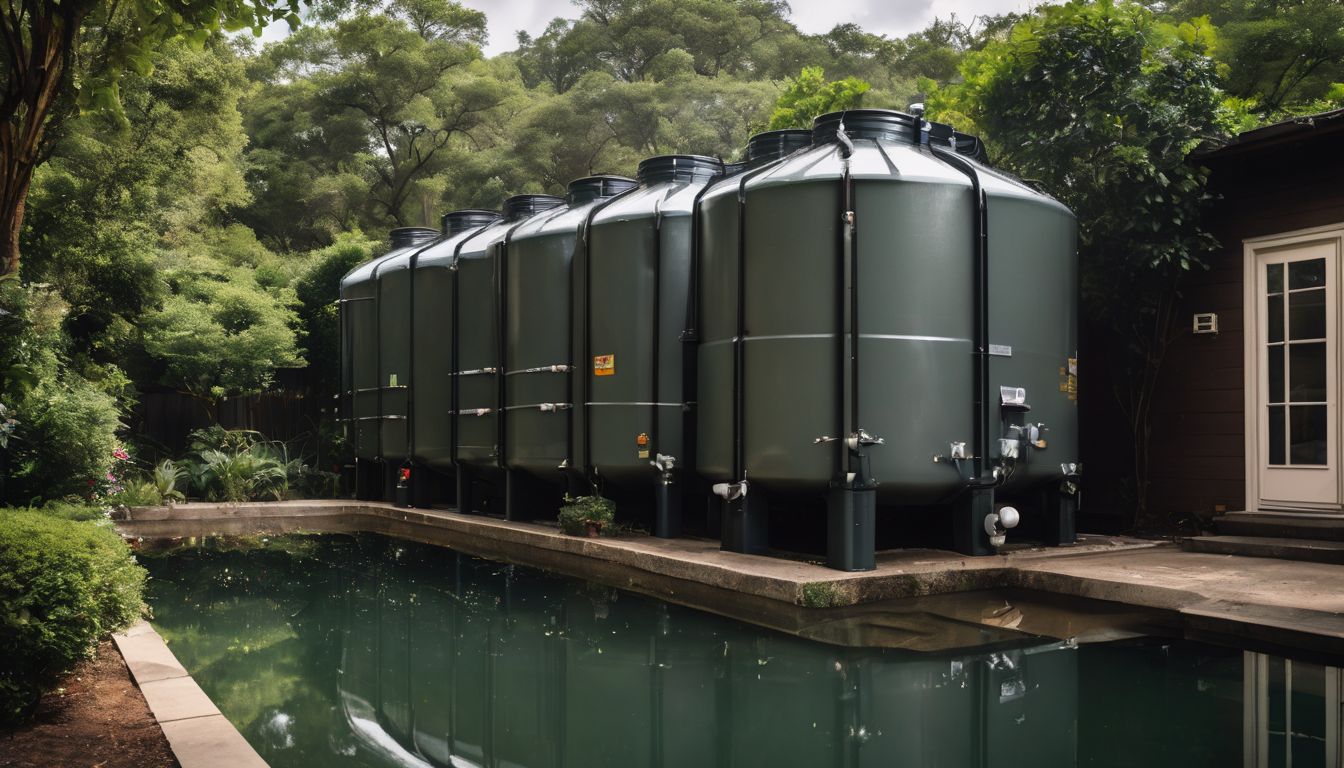Are you looking for ways to reduce waste and enrich your community’s soil at the same time? Community composting is a thriving movement, transforming kitchen leftovers into valuable plant food across towns and cities.
Our guide will walk you through the essentials of setting up your own local scheme, from starting small to growing a sustainable project that benefits everyone involved. Let’s dig in!
Key Takeaways
- Enrolling in a compost training course is essential to gain the skills needed for successful community composting.
- Select an easily accessible location for your compost site and collaborate with local partners like schools or businesses.
- Only accepted types of food scraps should be dropped off at community compost sites; check what’s allowed before participating.
- Store food scraps in airtight containers lined with paper or compostable liners to prevent odors until they can be taken to the drop-off point.
- Regularly dropping off food scraps ensures efficient operation of the community compost and helps reduce landfill waste.
Why Community Composting is Important
Community composting is important for the environment as it reduces greenhouse gas emissions, conserves water, and enriches soil. It also benefits the community by providing local green spaces and creating a sense of environmental responsibility.
Benefits for the environment
Composting organic waste significantly cuts down on greenhouse gas emissions, particularly methane, which is many times more potent than carbon dioxide. Diverting food scraps and garden trimmings from landfills means these materials break down in a controlled setting.
This process avoids releasing harmful gases into the atmosphere and turns potential waste into valuable compost.
Using finished compost can improve soil health immensely, fostering stronger plant growth and reducing the need for chemical fertilisers that contribute to pollution. Local green spaces thrive with the addition of nutrient-rich compost, supporting biodiversity and creating healthier urban environments.
Moreover, sustainable waste management through community compost schemes bolsters conservation efforts by nurturing an eco-conscious mindset among residents.
Benefits for the community
Community composting programs offer several benefits to the local area. Residents can reduce their waste and contribute to the community’s sustainability efforts. Moreover, community compost sites can create a sense of unity and cooperation among residents as they work together towards environmental conservation goals.
Additionally, these initiatives also provide an opportunity for educational outreach, where locals can learn about the importance of organic waste management in preserving green spaces and supporting urban agricultural projects.
By participating in a community composting scheme, individuals become actively involved in promoting environmental sustainability within their neighbourhoods. This fosters a shared commitment to reducing organic waste and building a greener future for everyone.
Steps to Starting a Community Composting Project
Take a compost training course to learn the basics. Choose a suitable location and partners to collaborate with. Decide on the stage of composting (e.g., collection, processing) you want to tackle first.
Become an advocate for community composting and raise awareness in your local area.
Take a compost training course
Enrol in a compost training course to gain essential knowledge and skills for successful community composting. Learn about the different stages of composting, proper handling of organic waste, and best practices for maintaining a healthy compost pile.
Enhance your understanding of environmental benefits and local regulations surrounding composting, empowering yourself to advocate for sustainable waste management in your community.
Become proficient in managing both green and brown materials, while also discovering effective methods for troubleshooting common issues that may arise in the composting process. Acquiring this expertise will enable you to confidently lead and support community efforts towards environmental conservation through organic waste recycling.
Choose a location and partners
Selecting the right location for your community compost site is crucial. Look for a space that is easily accessible to local residents and where there’s enough room for compost bins or systems.
Consider partnering with local businesses, schools, or community organisations to broaden your impact and create a network of support.
Collaborating with like-minded partners can help spread the word about your community composting initiative and increase participation. Seek out potential partners who share your environmental values and are willing to contribute resources or time to make the project successful.
Decide on the stage of composting to tackle
When starting a community composting project, consider the stage of composting to tackle first. You can begin with primary composting if you want to start from scratch and manage the entire process.
This involves collecting materials and creating the initial pile. Alternatively, you may opt for secondary composting where the partially decomposed materials are already collected, making it easier to handle.
Become an advocate for community composting
Encourage your local community to embrace composting by sharing its benefits with friends and neighbours. Educate them on the positive impact of reducing organic waste in landfills and creating nutrient-rich soil for gardening and landscaping.
Organise workshops, social media campaigns, or neighbourhood meetings to spread awareness about the advantages of community composting.
Engage with local authorities and businesses to advocate for policies that support community composting initiatives. Collaborate with environmental organisations, schools, and local influencers to promote sustainable practices within your community.
Types of Community Compost Drop-Off Programs
On-site community composting and off-site drop-off programs are two common types of community composting options. Learn more about the benefits and processes of each to find the best fit for your local area.
On-site community composting
Start a composting program in your community by setting up an on-site community composting facility. Engage local partners and secure a suitable location for the project. Advocate for the benefits of on-site community composting, such as reducing organic waste and providing nutrient-rich soil for green spaces.
Encourage environmentally conscious individuals to participate in this eco-friendly initiative that contributes to local environmental sustainability.
Ensure proper storage containers are available for food scraps between drop-offs at the on-site community compost site. Offer guidelines to prevent odors and maintain cleanliness at the composting facility, ensuring a pleasant experience for those dropping off their organic waste.
Off-site drop-off programs
To cater to individuals who are unable to compost at home or in their neighborhood, off-site drop-off programs provide a convenient solution. Participants can collect their food scraps and deliver them to designated community compost sites.
These programs often partner with local businesses or farmers’ markets where residents can easily drop off their organic waste for proper disposal.
In addition, these drop-off points typically accept a wide range of organic materials like fruit and vegetable peels, coffee grounds, eggshells, and yard waste. This initiative not only diverts organic waste from landfills but also encourages community members to actively participate in environmental conservation efforts.
How to Store Food Scraps between Drop-Offs
Proper storage containers and tips for preventing odors are essential for storing food scraps between drop-offs. Learn more about effective food scrap management by reading the full blog post.
Proper storage containers
Choose the right storage containers for your food scraps. Opt for airtight bins or buckets with tight-fitting lids to prevent odours and keep pests away. Line your containers with compostable bags to make clean-up easier and reduce mess.
When choosing storage containers, consider the size that best fits your household’s needs. Make sure they are easy to transport to the drop-off site yet large enough to hold all of your food scraps between drop-offs.
Look for durable, washable materials to ensure longevity and ease of cleaning.
Tips for preventing odors
To prevent odours, use airtight containers for food scraps. Line these with paper or compostable liners and empty them regularly to keep smells at bay. Store the containers in a cool, dry place away from direct sunlight to minimise odour buildup.
Sprinkling baking soda or layering food scraps with leaves can also help absorb odours while keeping your compost balanced.
When dropping off food scraps at a community compost site, consider transporting them in sealable bags or containers to contain any potential odours during transportation. Also, ensure that the drop-off location has good ventilation and is well-maintained to prevent odour issues.
How to Drop Off Food Scraps at a Community Compost Site
When dropping off food scraps at a community compost site, ensure that you are only depositing accepted food scraps and adhere to the frequency of drop-offs. Find out more about the dos and don’ts of community composting drop-off programs in our blog post!
Accepted food scraps
Community compost sites typically accept a variety of food scraps including fruit and vegetable peels, coffee grounds, tea bags, eggshells, bread, grains, and pasta. These organic materials are rich in nutrients and break down easily to create high-quality compost for community gardens or local green spaces.
By ensuring that only acceptable food scraps are dropped off at the compost site, it helps maintain the quality of the composting process and reduces contamination.
To effectively contribute to your community’s composting effort, it’s important to understand what types of food scraps are accepted at your local facility. Educating yourself on these guidelines will help you support the success of your community’s composting program while reducing organic waste sent to landfills.
Frequency of drop-offs
When dropping off your food scraps at a community compost site, it’s essential to be mindful of the frequency. Consider how often you generate food waste and plan your drop-offs accordingly.
Ensuring regular visits to the compost site helps maintain a clean and efficient process, contributing positively to the environment by diverting organic waste from landfills.
To determine the right frequency for drop-offs, assess your household’s production of food scraps and establish a convenient schedule that aligns with your routine. You can also coordinate with other community members to collectively organise drop-off days, optimising efficiency in utilising the community composting facilities.
Conclusion
In conclusion, starting a community composting scheme requires dedication and planning. Training courses can equip you with the necessary knowledge. Choosing suitable locations and partners is crucial for success.
Advocating for community composting can help raise awareness and garner support. With proper storage containers and drop-off programs, the process can be efficient and beneficial for both the environment and the community.
FAQs
1. How do I start a community composting programme?
To start a community composting programme, organise a group interested in environmental conservation projects, and set up compost facilities for organic waste collection.
2. What are the benefits of setting up a local composting scheme?
A local composting scheme can reduce green waste disposal issues and provide nutrient-rich compost for use in UK green spaces.
3. Where can I find community composting near me?
Look online or contact your local council to find existing community composting programmes near you or get advice on starting your own.
4. Can we use our community’s food scrap drop-off for the programme?
Yes, incorporating food scrap drop-off points into your urban composting initiative helps collect scraps that contribute to the eco-friendly project.
5. What strategies work best when advancing composting with my neighbours?
Effective outreach strategies include educating your neighbourhood about the benefits of joining the neighbourhood composting effort through workshops or informational flyers.





